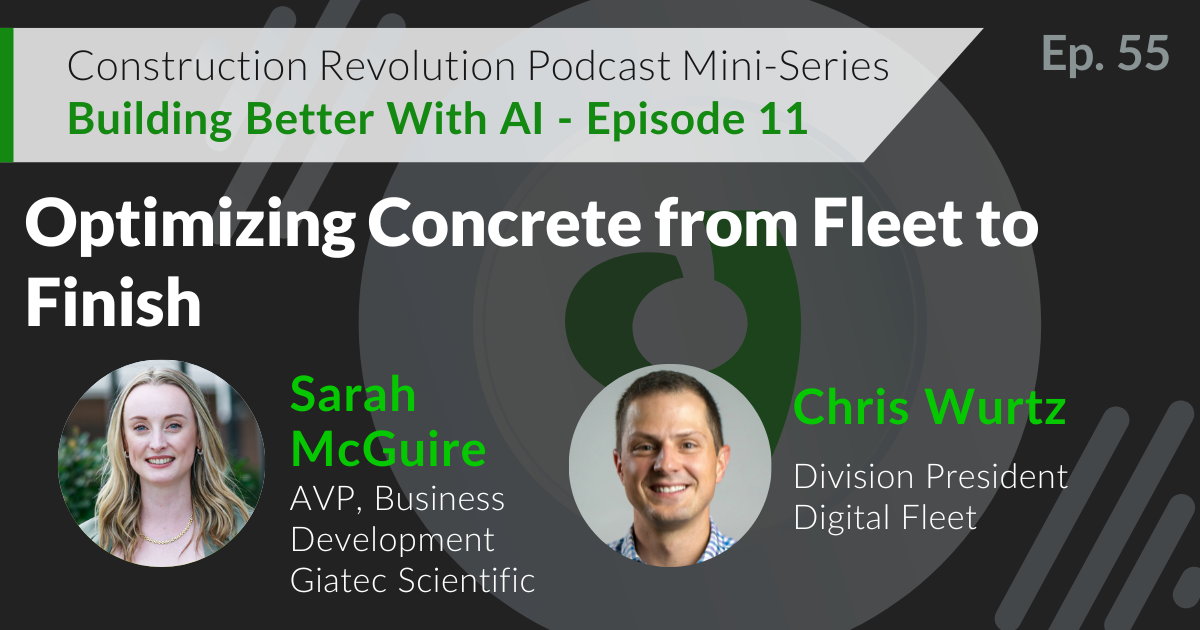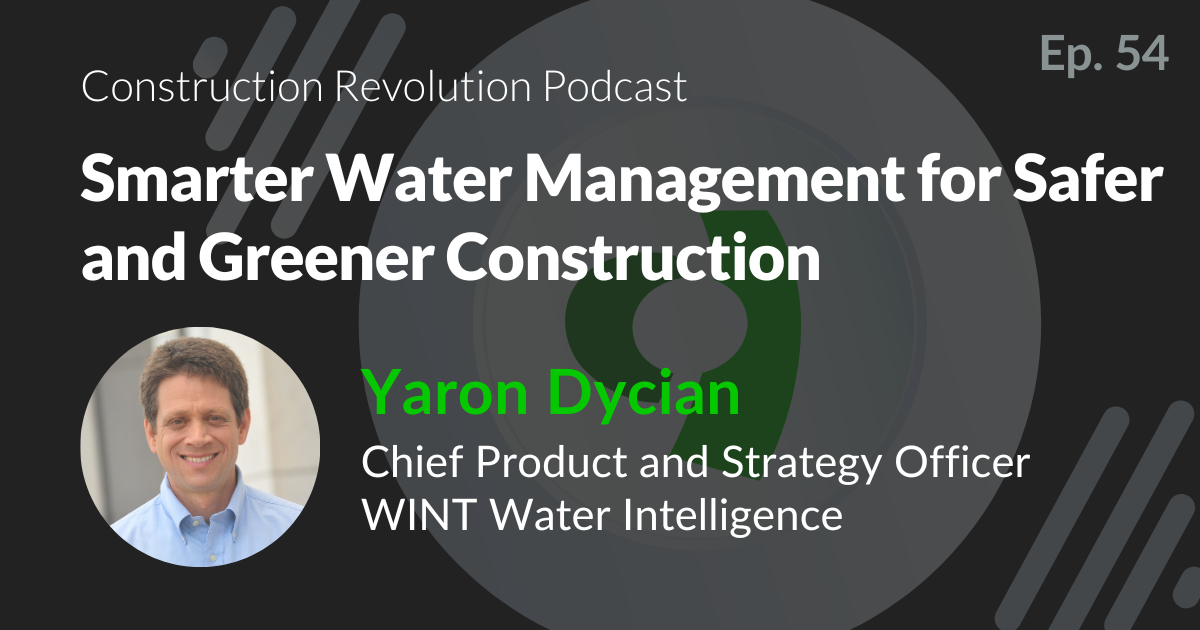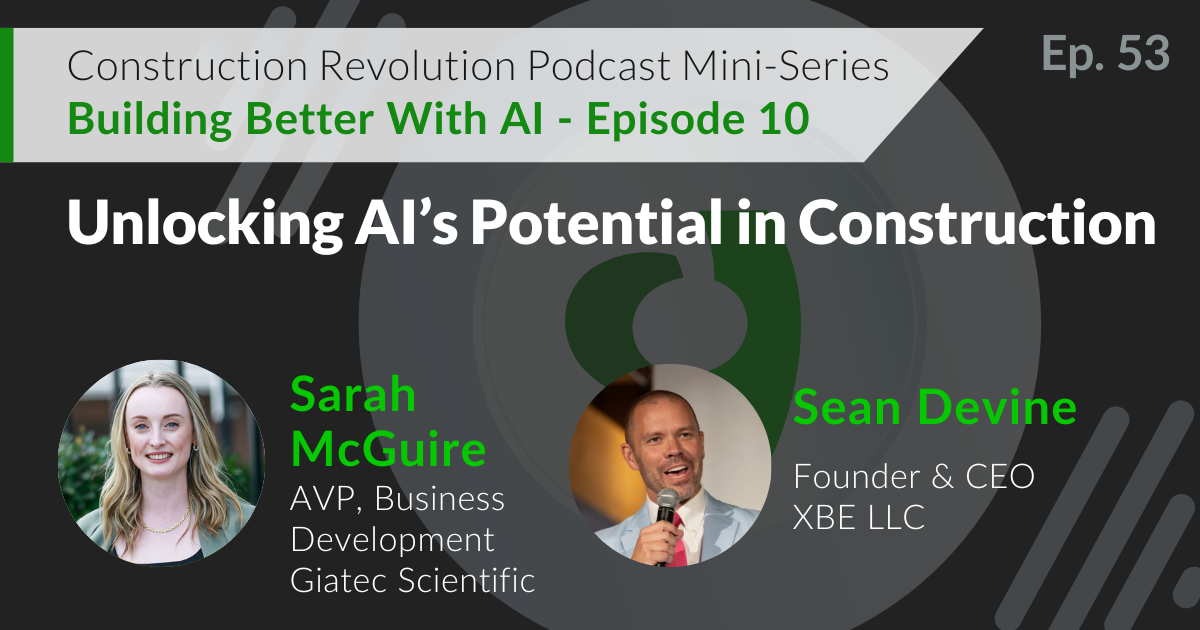
Episode 9 |
April 27, 2021
Robotics and Precision Data Collection on Construction Sites
In This Episode
On this episode of the show Boston Dynamic’s Brain Ringley and Trimble’s David Burczyk come on to discuss the technological collaboration between their companies. Trimble and Boston Dynamics collaborate to deliver a seamlessly integrated solution between Spot the robot and premier data collection systems including GNSS, RTS, and 3D laser scanning.

Host
ERIC YEE
Content Marketing Manager, Giatec Scientific Inc.
Guests

BRIAN RINGLEY
Construction Technology Manager, Boston Dynamics
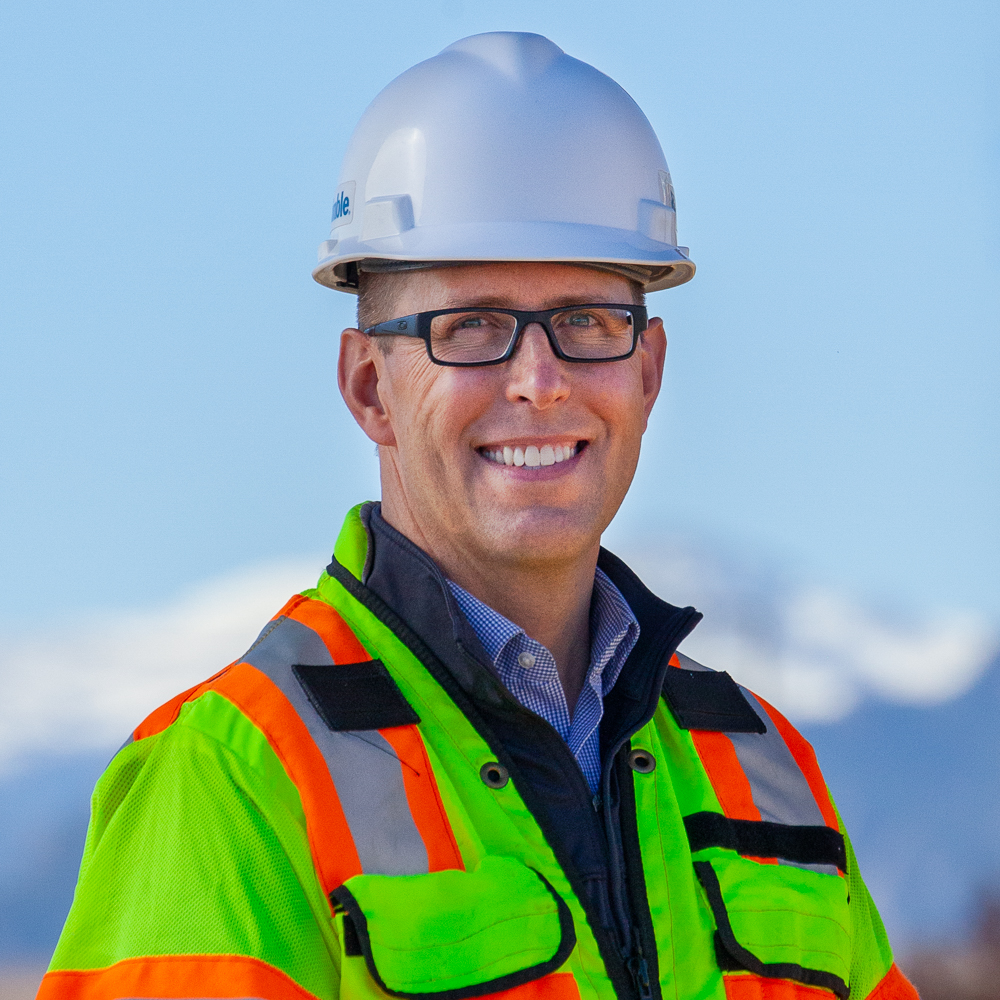
DAVID BURCZYK
Construction Robotics Lead, Connected Construction at Trimble Inc.
Podcast Transcript
Eric:
Hello there and welcome to The Construction Revolution podcast. My name is Eric Yee and here on the show we explore the latest trends, technologies, people, and organizations that are revolutionizing or disrupting the construction industry and changing what the industry will look like tomorrow. Today on the show I’m speaking with Brian Ringley from Boston Dynamics and David Burczyk from Trimble. Brian Ringley is a construction technologist at Boston Dynamics where he promotes new value add autonomous capabilities for construction project delivery, and works to expand the construction application ecosystem with a Spot SDK. Prior to Boston Dynamics he was a senior construction automation researcher at WeWork where he managed the construction robotics research program and contributed to initiatives and design automation, unitize prefabrication and construction site progress monitoring. He is also taught architecture courses for many years and most recently at Pratt Goud where he led seminars in computational fabrication and industrial robotic automation for industrialized construction.
Eric:
David Burczyk is the construction robotics lead at Trimble where he’s responsible for the business area management and the strategic product development of the Trimble construction robotics solutions. With over 20 years of AEC initial experience promoting technology and collaboration among design and construction teams, David is focused on the development and implementation of tailored construction robotics solutions to advance the field productivity of AEC contractors, architects and engineers. This is a really fun episode with some really cool tech so I know you’ll enjoy it so let’s get to the interview just after this.
Eric:
Brian, I would love if you could set up for our listeners who may not be familiar, could you explain exactly what Spot is and then maybe David afterwards you can tell us about the particular Trimble technology being utilized in this partnership.
Brian:
Yeah I’d be happy to. Spot is our general agile mobile robot platform and what that means is it’s a robot then it gives you the capability to carry or bring sensors into a lot of environments that had previously been difficult to bring automation into. And specifically it’s a quadriplegic robot meaning it’s a four legged robot and those legs are part of its differentiating advantage to be able to maneuver in difficult environments like construction sites and also I think more informally people like to just call it a robot dog.
David:
And on the Trimble piece, the integration there with Spot is to really bring robotics to the construction site. Trimble is known for its positioning technology and so we are combining with Spot as a payload. Three of our instruments that we use for positioning or documenting site conditions so we have our X7 laser scanner to use as a reality capture device to capture kind of your as is conditions on the project site whether that’s at the start of construction or during construction or even post-construction as you go into facilities management. And then we’re also studying workflows using our robotic total stations so for doing set out and lay out on a project site and then also positioning using our GNSS smart antenna and one of the neat things there is that we have a software that controls all three devices called Trimble Field Link and that’s same software that then is used as a controller for those devices will also be integrated to operate Spots. One of the unique features that we provide through this partnership is the ability to bring the robots out to the job site but then you have one software that’s controlling multiple solutions depending on what your workflows are on the job site.
Eric:
What are some of the major use cases that we’re seeing on construction sites to use these two technologies together?
David:
With the laser scanning side of things one of the major ones that we’re seeing is just a documentation of construction progress. Going out and just capturing the scans as constructions being put in place and then using it as a comparison against the construction model that’s being used as a coordination model.
Brian:
And I think part of what Spot’s really contributing to this that allows it to be a transformative technology for customers is it makes the act of scanning easier and less labor intensive which opens the door to being able to scan more frequently which in turn opens the door to be able to use scanning not just as a kind of survey or due diligence technology performed once and twice at a very high cost per project but is something that you are continuously doing in order to track your project progress.
Eric:
Prior to this we might’ve had someone mainly walking around maybe going into areas that could be dangerous and manually surveying but then maybe a week later it could be someone else doing it and they have… They see things differently or do things in a different way and then they’re going back and manually reporting some way where we Spot consistently going around, very standardized and always automated and sending data backup to the cloud sort of thing. Right?
David:
That’s correct. It’s that kind of automated workflow from a scanning standpoint. Like Brian was mentioning the amount of information you get through just that data capture is incredible but the process to do it is very time consuming and also very tedious for a human to perform. And that’s where the use of robotics on a site really comes into play because then you let the robot take over that task from the human so that then you start to take advantage of the value that you get from having that documentation and all that measurement data but then you let the people who are on site be able to focus their energies on the more valuable tasks for their time and then let the robots take over those kinds of dull and redundant tasks. But then the greater value is that then you have all this immense data that could be used to track progress of construction.
Eric:
Construction it’s one of the most versatile industries on the planet so how does Spot and Trimble payload kind of work together and say, “Urban construction versus in the middle of nowhere subject to the elements.”
Brian:
That’s a great question actually. Anyone who’s been on a job site knows how chaotic it is and Spot is utilized across multiple industries but the construction environment is really the test by which we’re able to evaluate the effectiveness of our autonomy which is to say if the robot can perform here it can pretty much perform in any environment and then we get the further value add kind of what specific sensors, hardware, processes, data workflows are our construction customers helping bring in? Trimble is the natural partnership for that and beyond the X7 laser scanning which I think it’s primarily deployed for kind of commercial interior environments but we’re also seeing a lot of use cases in outdoor and civil environments. We’re also integrating GNSS technologies and I’ll let David speak a little bit more about that.
David:
The GNSS technologies are really good for those kind of remote environments where you’re not in that kind of urban core where you’re using… Positioning through satellites to be able to document topographic conditions and different kinds of site conditions that way. A lot of contractors that we’ve been working with are using it as a way of also just navigating with Spot on a remote work site so that they can then use either the laser scanner or 360 cameras combined with that GNSS antenna to document the conditions on those projects that are in remote locations. They have the capability to actually access Spot remotely and operate in that kind of autonomous fashion and then the GNSS technology is helping it to navigate itself through those remote sites. And so it’s being used to document things, collect those topographic conditions and things of that nature.
Eric:
There was one thing I wanted to ask is, is there an operator running Spot? Is there a remote control at all times? Or like you said is it fully autonomous from 200 miles away kind of overseeing it?
Brian:
In the kind of base product, we’ve really offered a full spectrum of different ways to operate the robot. There’s the desire for autonomy, there’s the needs to be able to remotely supervise that autonomy and then there’s also remote operation which could be autonomous or could be teleoperation in which case a human is directly in control because whatever’s being inspected requires that level of intelligence. When you’re recording a mission by default you are there within line of sight of the robot to basically tell the robot where you want it to go and what you want it to do such as trigger a laser scan or take a photo. Once that’s saved, the robot can go out and do that autonomously.
Brian:
Now you could choose to maintain a connection to that robot either by following up with the tablet or remotely by using your corporate Wi-Fi, LTE or 5g or even radio systems or we even have features where if you’re in an environment where it is safe for you to do so you can turn off that need to be connected to the robot in which case it is truly autonomous. And one of the things we’ve been working on with Trimble as well is this GNSS integration which is an autonomous feature that basically says, “I want you to go to a sequence of lat-long coordinates.” And then the robots off to the races.
Eric:
For someone like me who might be operating Spot for the first time I don’t need any programming knowledge in order to get to work on my job site, it’s just a matter of putting in the latitude and longitude and teaching it the tasks that we want it to perform or the area to perform it in.
David:
Yeah, and that’s part of the whole integration with the Trimble solutions because the way that we’ve built the fielding software is to make it very user-friendly and open it up to a wide range of audiences working with the technology. A lot of those kinds of tasks or procedures that you would think would be very technical, we automate that in the background for the software to take care of so then you have confidence that you’re still getting the level of accuracy and the level of precision that you’re expecting but you’re letting the software take care of that for you so we can open it up to a larger use of people on a project.
Eric:
That’s amazing. I know we touched on some of the different use cases, I’m just wondering from the customers that you work with so far what kind of applications are having the most impact for them?
David:
We have an early experience program that’s underway right now at Trimble and what that program is focused around is really engaging these kinds of forward-thinking customers that want to take the technology and start to work with it. And so a lot of them are using it a standpoint of being able to evaluate just the progress of construction, documenting that so that’s where a lot of the laser scanning use cases are coming into play. On the civil construction side of things it’s more of those topographic surveys and have Spot out there collecting measurement data across a large site and be able to turn that into a topographic survey.
And then we have other kind of operations where it’s part of the highway construction checks where we have some precast panels or spandrels being put into place and instead of putting a human at risk to inspect those as they get installed, you know, these are spans that could be 100 feet up in the air and instead of having a human walk that to check it and make sure that things got placed correctly, we can send Spot across those walks and things like that and have Spot be in the position that’s up high and enable the safety of the individual without having to go through that. A lot of different use cases. The most common one is probably focused on scanning just a document kind of conditions and be able to compare that back to what’s been coordinated and then tie that into your construction schedule and then doing those topographic servers around the GNSS technology.
Brian:
I think that related to that we talk a lot with our customers about ROI with this technology and it’s easy to quantify the reduction of the labor required. Basically there’s an obvious value here because you can get more data which is apparently valuable with less resources but then there are these other opportunities that are much more valuable. We know that instinctively that they are a lot harder to quantify. Safety, right? Seems pretty priceless anytime you can remove someone from a potentially harmful or hazardous situation as well as progress monitoring. If you have the ability to close the loop and get a near real-time information about what’s happening on site, if you catch a big mistake that early that can save you a huge amount of money but the joke I think people make is it’s like selling insurance. You’re not sure exactly if you’re going to need it or not but it ends up kind of being an inevitability on the site and I do think there’s some really big savings there.
Eric:
That makes a lot of sense kind of relative why I bought my dash cam for insurance.
Brian:
Exactly.
Eric:
But I know one thing we’ve touched on it few times was the data collected. I remember we mentioned that we can use it for topographical maps and things like that. I’m wondering because it’s collecting all this visual data that you wouldn’t really collect otherwise and analyze, what are some companies doing with all that extra data in terms of the analysis or kind of looking towards future?
David:
It starts to become a deliverable as part of the project. It starts to transition into the life of the building so that becomes that. You hear the term digital twin that’s really what you start to see as it’s the true as built condition of what’s being put in place from a construction standpoint. That information can start to live with the building so that then even as constructions passed and you’re more into just the general day to day operations of the facility, you have that information showing you where things were built and if you make repairs to the building or if you’re going to do any kind of upgrades or master planning to a larger campus for instance, you have this kind of digital information that’s very accurate from a measurement standpoint that can be used from a planning standpoint as well and just tracking kind of the overall life of the building.
Brian:
And I think that we’re well aware two of the potential risks of having more data, right? It doesn’t just do you got to have more data so Trimble has some really great tools around being able to take those clouds and register those in the field so when they get to the stakeholders they’re actually ready to be used there’s not a lot of additional process in time there. We also recognize that these files can be large so on one side of things we give you the ability to customize the parameters for each scan in the mission so that you’re being efficient with what you’re collecting in the first place relative to your use case but then Trimble’s also utilizing our enterprise robot which comes with a doc. And that doc is really useful for a number of things the most obvious being that that’s what the robot uses to self-charge but that’s also a place where while the robot is charging it has a gigabit ethernet connection and can be uploading those larger files to remote network locations so that they can be processed. We do understand that we have a vision that this is kind of an end to end data workflow and we are opening up new capabilities in terms of realizing the amount of data we’ve always wanted to have from job sites but we’re also trying to be really intelligent about allowing customers to manage that efficiently in an automated way.
David:
That’s one of the values with the Field Link application as well that’s, that’s controlling not only Spot but the Trimble payloads as well is that especially with that scanning workflow and Brian alluded to this is that as the mission is taking place and you’re documenting the site, those scans are being registered in real time on board Spot so that by the time that mission is complete and Spot comes back to that docking station, you have a registered set of data. It takes time out of the equation because you don’t have to have a person coming back and going through… Taking the time to process all that data that got collected. Now you have a packet of information that’s already registered and then can go to that kind of cloud hosting location to where then he can create an overall assembly of the entire building and then start to run analysis on that automatically.
Brian:
That’s why this is a construction solution because it’s not just about automating the capture. That’s the obvious part of what we’re doing here but we’re really looking at this as how do we automate and augment this end to end workflow?
Eric:
It seems for a construction company there’s so many upsides to why they want to invest in this technology and start utilizing it. I’m not sure what the sales process is like but when you are approaching customers or when they’re speaking to you, is there any hesitancy about adopting this new technology because it’s such a cutting edge product?
David:
There’s lots of energy and just enthusiasm in general across all the different trades involved in construction as well as just the general contractors and to the facilities owners. What I’ve found really exciting about the whole process is just the number of contractors that have their own internal innovation teams that are actively researching how they can take this technology and add it into their day-to-day workflow. They definitely see that this is where the future is going in terms of just augmenting today’s workforce and they’re actively starting to just dive into how does it become part of their workflow.
Brian:
I think the construction industry sometimes gets a bad rap for kind of lagging productivity metrics over the years but it’s a very high-tech industry and a very mature technology ecosystem. It’s actually what’s made it so easy to introduce Spot into the construction market especially because a partner like Trimble already existed and really knew how to combine this technology with what they were already working on in a transformative way. And beyond I think GC is being self-motivated and these innovation groups proactively seeking to push tech and solve business problems in their companies. We’re seeing some owner mandates the first tricklings large owners saying, “I expect this site to these scanned regularly. I expect you to have a robust data capture workflow as a routine part of building delivery here.” I think those innovative customers are one step ahead of the curve because this will become commonplace and they’ll have a leg up on competition by engaging with us early on.
Eric:
David and I we’re kind of talking about before the show is that the pace of innovation in a lot of these areas is just exponentially growing but if you don’t jump in it’s going to be very easy to be kind of pushed out on `certain projects or even be considered possibly if you can do those proactive site scans.
David:
Yeah.
Brian:
Yeah, and we… Sorry. Go ahead David.
David:
That’s exactly kind of what Brian was talking about earlier was just when I first came to Trimble at that time it was the introduction of robotic total stations onto job sites and showing the value of taking the 3D model that was being planned in an office and accurately bringing that out to the job site and that’s where the robotic total stations were coming into play. And so you had forward thinking customers that were embracing that technology, making that connection between field and office and now that’s technology that’s just… It’s a given on projects and you see that in the tenders that go out for a project where it says you must have these types of technology in order to bid for the project and so that’s the trend that you’re seeing as well with this. It’s the forward-thinking customers and the forward-thinking contractors are diving into it seeing how it becomes part of their workflow you have the owners mandating it as well. It’s that same kind of trend where it’s kind of an education level right now and then that becomes the next norm that just becomes a standard for every project.
Brian:
David and I both have extensive industry experience before moving kind of onto the technology side of things but that said, we stay humble. We know that our customers have a vast amount of expertise and that they know their business challenges best so a key part of our early experience program is the amount of support and collaboration with our customers to allow them to define the product and help move this forward in a way that’s meaningful for them. We were bullish and we know that this is valuable and we’ll scale but we also know that we can’t do it alone without working and partnering with our customers.
Eric:
It’s like everyone has to take the journey together to get to the ends that we all want to get to.
Brian:
Absolutely.
David:
Absolutely.
Eric:
If I’m on the job site and someone puts Spot down in front of me with the Trimble payload, how do I get it working? What’s next for me to go from maybe someone who’s inexperienced with the product to becoming comfortable using it day-to-day?
David:
This is where the integration with Field Link comes into play. Field link will be controlling not only the Trimble payload but also just the operation of Spot. When you come onto the job site… If we take the workflow using the laser scanner, you would come onto a job site and you’re going to train Spot on the mission that you want it to walk and collect data on. That’s your first step where you can go out, define what your mission is going to be so it’s just walking the site and then determining what’s the value for you to collect from the standpoint of a scan and then once you have that mission defined you run that mission. And as Spot is doing that mission going from waystation to waystation those scans are being collected and as the scans are taking place and they’re registering on board and then as the time when that mission completes you then have that fully registered point cloud of the area that you had defined as your mission. That’s the process and then going through Field Link as I was mentioning earlier the benefit of Field Link like is that it’s open to be very user-friendly so that then you have a larger audience being able to then interact with that from the standpoint of actually being able to use the technology.
Brian:
One of the stories I like to you is when we were first setting up the data software in order to do customer demos. We have a team of test ops people who really specialize in that and I was working the schedule time with them and saying, “I’ll train you on this and we’ll go over it.” And then I realized that they had already just picked it up and done it themselves and then sent me the data and I’m like, “Yep, scan looks great.” And I think that’s really key to this because we’re really trying to… Part of the value proposition here is to make this easy enough that it seamlessly fits into all of your field professionals workflows. You don’t need to hire a roboticist and in some cases you don’t even need to have somebody who specializes in VDC or survey and by doing that it just makes teams more nimble to be able to set up these missions and get that work going and then they can really use their highest value resource which is their team and allocate that more efficiently.
David:
When we go onto a job site training for any of the Trimble solutions, it’s usually a two-day event where just the first day is focused around this… Just explain what the technology is and how it works and operates and then the second day is just being on a job site getting flight time in the environment that you’re working in that you’re going to be using the technology for. Just getting you out there while you have someone that can kind of shadow you and just make sure that yes, you’re doing things the way you should be that just gives everybody the confidence but you’re not spending these extravagant amounts of time having to learn a technology, really just dive right into it and just build your own confidence through repeated use.
Eric:
When anytime we kind of introduce something, “I got of the products.” Or interact with customers things will always kind of surprise you. If there’s ever any interesting use cases or even just data or stories that you’ve heard from the field that kind of surprised you into how they’re using a Spot in Trimble?
Brian:
So many surprises. Some good some bad. Every day on site is a surprise as anybody who’s construction site knows and that’s why we have to stay humble. The first time that we ever saw a robot walk on a pre-poured floor, right? Which is just like decking and rebar was just a customer sending us a video that said, “Hey, check this out. This worked for us and now we can scan prior to pouring the slab.” And I was like, “I had specifically been telling customers the robot can’t do that.” Which is great. It’s great to see that all of the work that has gone into the dynamics and the stepping and the balance of anything that really differentiates Spot in these environments is producing these kinds of unexpected beneficial behaviors and in this case one that’s directly linked to a type of documentation that had previously been difficult to set up for and it’s slightly hazardous as well to step through those areas.
Brian:
We also have surprises that are kind of operational surprises, right? Some customers run lean sites. They have pathways that are dedicated to being clear for moving people through and materials through and that ends up being really useful for robots as well. And then we have some sites that are so chaotic that there might be an entire half of the floor that is just completely inaccessible not just to the robot but the people as well maybe they’re staging the curtain wall of a tower for example.
Brian:
It’s hard to understand that’s one of the challenges is like, “How is this site going to be run?” And How dynamic it is but that just gives us good understandings that it’s not so simple as saying, “Record this exact mission and execute this exact mission.” You have to build a lot of flexibility into that. Some of that flexibility is standard stuff like obstacle avoidance and the ability to stepping out unanticipated things but some of it goes into software development too which is creating flexible options for editing missions, sending useful messages to the operator that might allow them to make decisions on behalf of the robot and really understanding what’s acceptable and safe in operation and bringing that level of sophistication tier. There’s a reason that there aren’t autonomous robots already moving around job sites. It’s a really big problem.
Brian:
And then beyond that flooding. That’s a big one whether you’re wet sawing or it’s open to the elements you can get quite a bit of water or I can actually move through water up to its knee joints. It can wade before you hit anything that’s not electronic but huddles of water if they’re too still turn into mirrors and obviously introduce more friction. And then it can freeze when it gets cold and then you have a robot on ice and our behavior specialists really keep chipping away at these really hard robotics problems, but the point is that these aren’t just edge cases these are realities of the unpredictable job site and we take those challenges head on.
David:
What I always like to see is the customer’s reaction when they’re surprised that Spot performed so well and in different environments. They might be afraid to… One customer was walking it down a railway and doing the kind of path inspection to make sure there’s materials out of the way and things of that nature and just to see their excitement and their confidence grow and just seeing Spot walking down a condition like that and not having a problem with that or going through a field in different applications and being able to navigate through those conditions. The surprise that those customers see it’s always exciting because then they realize that while this is a really robust platform that can handle those kinds of different conditions.
Brian:
Day one is always fun with the customers too because they tend to baby the robot. They don’t understand its capabilities and they’ve never seen anything like it, right? And then I’ll take the controller out of their hands and ram Spot up over a pile of loose materials and then they’re like, “Wow. This thing is really capable.” And then by the end of the day the robot’s caked in mud and you know you’ve had a successful Workday and now this is no longer a robot this is a useful tool then that’s an exciting thing to see.
Eric:
I can see from a user standpoint how cool it would be to get your hands on this and to become a proficient user with it but also from both of your perspectives working so long as everyone seeing it out in the world and people enjoying it then it must be incredible?
David:
Yeah. It’s a fun time to be in construction.
Brian:
Absolutely. And I was just going to say I started as a customer in late 2018 and it’s funny now thinking back then I was so excited about this. This was the first thing I had seen. There were limitations to drones indoors. I just really wasn’t having success with wheels or tracked vehicles in terms of getting everywhere I needed to get a camera onsite for photo documentation which is what we were working on at the time and then this legged thing comes in and can really get there. It fell down a lot more back then by the way and it’s funny as we’ve transitioned from can the robot get through the environment? Can the robot get through the environmental autonomously?
Brian:
And now we’re to the point where we’ve got sophisticated sensors and workflows on that with Trimble and then we’re also doing things with our APIs under that hood allowing again the robot to just make smarter decisions about how it moves through a site. Not only can I do this autonomously but can I do it and make smart decisions along the way? And all of that has really happened in goodness less than three years and we’ve really only been seriously on job sites with customers since the beginning of our original early adopting program in early 2020 which was sidetracked pretty massively by COVID. The progress is spectacular and I think David and I are so excited about… Can you even imagine what we’re going to have five years from now? It’s really mind blowing.
Eric:
It’s amazing. Definitely two people that I will be paying close attention to your LinkedIn pages to see what the latest developments are.
David:
Absolutely.
Eric:
I have one last question before I let you guys go. Now that we have our listeners all hyped up and super interested in getting their hands on Spot with Trimble’s data collection systems, how do they get their hands on it? Where are they going to order in?
David:
You can find out more information if you go to the Trimble webpage it’s called fieldtech.trimble.com. You’ll see not only the Spot integration but also all the Trimble solutions as well. That’s a great place to start where we can get you in touch with someone that’s in your area if you want to talk further and getting engaged around the early experience program or even just engage myself or the people running our early experience program and we can provide more information that way but it’s a great starting point to see all the solutions and then also talk about the integration itself.
Brian:
And the beautiful thing about what Trimble was doing too is they’re providing with their commercial solution. This is the place to go in construction where you can get the robot, the value add, sensors, the software, the mounting. You don’t have to figure any of that out yourself. If you just want a valuable autonomous scanning tool they will give that to you so you don’t have to worry about all the little bits and pieces that go into that. And that’s really new for us I think before there was… Excuse me. A fair amount of customization and attachment of things and that’s really part of our alliance and the exclusivity that Trimble has in the construction market for technologies like scanning and GNSS is the fact that they become that one-stop shop and that was in direct response to our customers saying, “Make this easier for us?”
Eric:
Sound like they kind of take care of everything and we will handhold the customers and answer all their questions and run everything that supported they needs. That’s fantastic.
Brian:
David is got you covered.
David:
Yeah. That’s right.
Eric:
We’ll make sure I’ll link your website in the show notes but David, Brian thank you so much for coming on the show today I really appreciate your time.
David:
Great to be here.
Brian:
Thanks for having us.
Other Related Episodes
Episode 55 |
February 27, 2025
Optimizing Concrete from Fleet to Finish
In this latest episode, host Sarah McGuire speaks with Chris Wurtz, Division President at Digital Fleet, about the impact of data-driven decision-making in the ready-mix concrete industry. With expertise in fleet tracking technology, Chris sheds light on the challenges and opportunities of controlling what he calls a “factory on wheels”—the mixer truck. He explores the biggest obstacles facing producers today, from data limitations to inefficiencies in delivery, and highlights untapped opportunities to improve performance. Chris also discusses the vision behind Digital Fleet’s partnership with Giatec on MixPilot and how this integration is helping producers gain better control over their operations. Tune in for an insightful conversation on the future of ready-mix operations and how collaboration between technology providers is driving industry-wide transformation. Don’t miss this engaging discussion!
PLAY
Episode 54 |
February 6, 2025
Smarter Water Management for Safer and Greener Construction
In this episode of The Construction Revolution Podcast, Steven Rossi sits down with Yaron Dycian, Chief Product and Strategy Officer of WINT Water Intelligence. With over 25 years of experience driving strategy and innovation at leading companies like IBM and RSA, Yaron is leading the charge in AI-powered water management solutions. Tune in as Yaron shares the story of WINT, explores the rising challenges of water damage claims, and discusses how advanced monitoring and leak mitigation technologies are shaping the future of construction. From preventing costly damages to meeting sustainability standards and lowering carbon footprints, this episode offers valuable insights into how construction companies can stay ahead in a rapidly evolving industry.
PLAY
Episode 53 |
December 12, 2024
Unlocking AI’s Potential in Construction
In this latest episode, host Sarah McGuire sits down with Sean Devine, Founder and CEO, XBE, to explore the transformative role of AI in the construction industry. With a background in logistics and technology, Sean brings unique insights into the challenges and opportunities surrounding AI adoption in construction. Sean highlights untapped opportunities and discusses how XBE is leading the charge with innovative solutions, including AskConcrete— a groundbreaking answer engine powered by decades of NRMCA data, designed to tackle complex questions about ready-mixed concrete. From identifying industry limitations to exploring what companies need to do to embrace AI effectively, Sean offers a compelling roadmap for innovation. He also shares his journey in founding XBE and his mission to optimize heavy construction operations with cutting-edge technology. Tune in to gain valuable insights into how AI is shaping the future of construction. Don’t miss this enlightening discussion!
PLAY
Want to Be a Guest Speaker, Sponsor, or Just Have a Question for Us? Fill In the Form!

